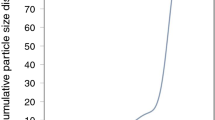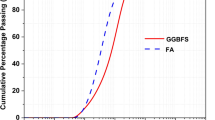The properties of lightweight geopolymer materials (GM) based on refractory technogenic aluminosilicate wastes were studied. The effect of the ratio of the oxides SiO2 and Al2O3 in the compositions of GM on the physical and mechanical properties of GM was investigated. It was found that SiO2/Al2O3 reduction in the GM composition results in higher density and strength and lower water absorption of the samples after a keeping period. After firing at temperatures 800 and 1000°C the strength of the samples becomes all the higher the lower the ratio SiO2/Al2O3 in the composition. The heat resistance of the samples comprises four thermal cycles for high and more than seven cycles low ratio SiO2/Al2O3.








Similar content being viewed by others
References
J. Davidovitz, Geopolymer: Chemistry and Applications, Institute Geopolymer, Saint-Quentin (2008).
V. I. Korneev and A. S. Brykov, “Prospects for the development of general building binding materials: Geopolymers and their distinctive features,” Tsement i Ego Primenenie, March – April (2010), pp. 51 – 55.
P. Duxson, A. Fernandez-Jimenez, J. L. Provis, et al., “Geopolymer technology: the current state of the art,” J. Mater. Sci., 42, 2917 – 2933 (2007).
Ch. Panagiotopoulou, E. Kontori, Th. Perraki, and G. Kakali, “Dissolution of aluminosilicate minerals and by-products in alkaline media,” J. Mater. Sci., 42, 2967 – 2973 (2007).
L. Weng, K. Sagoe-Crentsil, T. Brown, and S. Song, “Effects of aluminates on the formation of geopolymers,” Mater. Sci. Eng., 117, 163 – 168 (2005).
Á. Palomo, S. Alonso, A. Fernandez-Jiménez, et al., “Alkaline activation of fly ashes: NMR study of the reaction products,” J. Am. Ceram. Soc., 87, 1141 – 1145 (2004).
A. Fernández-Jiménez, A. Palomo, I. Sobrados, and J. Sanz, “The role played by the reactive alumina content in the alkaline activation of fly ashes,” Microporous Mesoporous Mater. 91(1 – 3), 111 – 119 (2006).
T. Bakharev, “Thermal behaviour of geopolymers prepared using class F fly ash and elevated temperature curing,” Cement Concrete Res., 36(6), 1134 – 1147 (2006).
R. E. Lyon, P. N. Balaguru, A. Foden, et al., “Fire-resistant aluminosilicate composites,” Fire and Mater., 4, 67 – 73 (1997).
G-M Tsaousi, I. Douni, M. Taxiarchou, et al., “Development of foamed inorganic polymeric materials based on perlite,” in: IOP Conference Series: Material Science and Engineering (2016), Vol. 123.
L. Korat, V. Ducman, A. Legat, and B. Mirtiè, “Characterisation of the pore-forming process in lightweight aggregate based on silica sludge by means of x-ray micro-tomography (microCT) and mercury intrusion porosimetry (MIP),” Ceram. Int., 39(6), 6997 – 7005 (2013).
J. Henon, A. Alzina, J. Absi, et al., “Porosity control of cold consolidated geomaterial foam: Temperature effect,” Ceram. Int., 38(1), 77 – 84 (2012).
D. M. Huiskes, A. Keulen, Q. L. Yu, and H. J. H. Brouwers, “Design and performance evaluation of ultra-lightweight geopolymer concrete,” in: 19 Internationale Baustofftagung, September 16 – 18, 2015, Weimar, Bundesrepublik Deutschland (2015), Vol. 2, pp. 1099 – 1106.
K. Pimraksa, P. Chindaprasirt, A. Rungchet, et al., “Lightweight geopolymer made of highly porous siliceous materials with various Na2O/Al2O3 and SiO2/Al2O3 ratios,” Mater. Sci. Eng., 528(21), 6616 – 6623 (2011).
P. Posi, C. Teerachanwit, C. Tanutong, et al., “Lightweight geopolymer concrete containing aggregate from recycle lightweight block,” Mater. & Design, 52, 580 – 586 (2013).
R. M. Novais, L. H. Buruberri, M. P. Seabra, et al., “Novel porous fly ash-containing geopolymers for pH buffering applications,” J. of Cleaner Production, 124(15), 395 – 404 (2016).
S. A. Bernal, E. D. Rodríguez, R. M. de Gutiérrez, et al., “Mechanical and thermal characterisation of geopolymers based on silicate-activated metakaolin/slag blends,” J. Mater. Sci., 46, 5477 – 5486 (2011).
R. P. Williams and A. van Riessen, “Determination of the reactive component of fly ashes for geopolymer production using XRF and XRD,” Fuel, 89, 3683 – 3692 (2010).
W. D. A. Rickard, J. Temuujin, and A. van Riessen, “Thermal analysis of geopolymer pastes synthesised from five fly ashes of variable composition,” J. Non-Cryst. Solids, 358(15), 1830 – 1839 (2012).
Y. Zhao, J. Ye, X. Lu, et al., “Preparation of sintered foam materials by alkali-activated coal fly ash,” J. Hazardous Mater., 174(1 – 3), 108 – 112 (2010).
D. L. Y. Kong, J. G. Sanjayan, and K. Sagoe-Crentsil, “Comparative performance of geopolymers made with metakaolin and fly ash after exposure to elevated temperatures,” Cement Concrete Res., 37(12), 1583 – 1589 (2007).
T. S. Lin, D. C. Jia, P. G. He, and M. R. Wang, “Thermomechanical and microstructural characterisation of geopolymers with alpha alumina particulate filler,” Int. J. Thermophys., 30, 1568 – 1577 (2009).
F. J. Silva and C. Thaumaturgo, “Fibre reinforcement and fracture response in geopolymeric materials,” Fatigue & Fracture Eng. Mat. & Struct., 26(2), 167 – 172 (2003).
E. Kamseu, A. Rizzuti, C. Leonelli, and D. Perera, “Enhanced thermal stability in K2O-metakaolin-based geopolymer concretes by Al2O3 and SiO2 fillers addition,” J. Mater. Sci., 45, 1715 – 1724 (2010).
A. Buchwald, M. Vicent, R. Kriegel, et al., “Geopolymeric binders with different fine fillers – phase transformations at high temperatures,” Appl. Clay Sci., 46(2), 190 – 195 (2009).
P. Duxson, G. C. Lukey, S. J. Jannie, and J. S. J. van Deventer, “Physical evolution of Na-geopolymer derived from metakaolin up to 1000°C,” J. Mater. Sci., 42(9), 3044 – 3054 (2007).
V. F. F. Barbosa and K. J. D. MacKenzie, “Synthesis and thermal behaviour of potassium sialate geopolymers,” Mater. Lett., 57(9 – 10), 1477 – 1482 (2003).
J. L. Bell, P. E. Driemeyer, and W. M. Kriven, “Formation of ceramics from metakaolin-based geopolymers. Part II. K-based geopolymer,” J. Am. Ceram. Soc., 92(3), 607 – 615 (2009).
L. Dembovska, G. Bumanis, L. Vitola, and D. Bajare, “Influence of fillers on the alkali activated chamotte,” in: IOP Conf. Series: Material Science and Engineering (2017).
V. Antonoviè, M. Šukšta, I. Pundienè, and R. Stonys, “Procedural elements in estimation of the thermal shock resistance of different types of refractory concrete based on chamotte filler,” Refract. Industr. Ceram., 52(1), 70 – 74 (2011).
F. Benboudjema, E. Guillon, and J. Torrenti, Effect of Interfacial Transition Zone and Aggregates on the Time-Dependent Behavior of Mortar and Concrete (2002); URL: http://www.framcos.org/FraMCoS-5/Benboudjema.Effect.PDF.
A. Fernandez-Jimenez, J. Y. Pastor, A. Martýn, and A. Palomo, “High-temperature resistance in alkali-activated cement,” J. Am. Ceram. Soc., 93(10), 3411 – 3417 (2010).
T. Pyatina and T. Sugama, “Set controlling additive for thermal-shock-resistant cement,” GRC Trans., 38, 251 – 257 (2014).
Author information
Authors and Affiliations
Corresponding author
Additional information
Translated from Steklo i Keramika, No. 3, pp. 34 – 40, March, 2018.
Rights and permissions
About this article
Cite this article
Dembovska, L., Pundiene, I., Bajare, D. et al. Effect of the Ratio SiO2/Al2O3 on the Structure, Properties, and Thermal Stability of Geopolymer Refractory Materials. Glass Ceram 75, 112–117 (2018). https://doi.org/10.1007/s10717-018-0039-0
Published:
Issue Date:
DOI: https://doi.org/10.1007/s10717-018-0039-0




